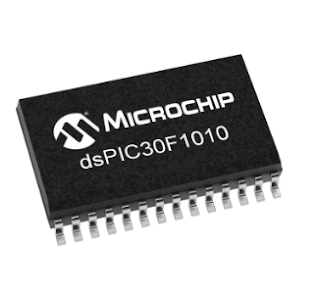Microchip dsPIC30F1010 is a 16-bit micro-controller, targeting for Switch Mode Power Supply (SMPS) Digital Signal Controller (DSC). It comes with many features that I don't show them all here. It has DSP (Digital Signal Processor) engine. It's 10-bit ADC module is able to convert analog signal up to 2Msps. Central Processing Unit (CPU) executes up to 30MIPS.
dsPIC30F1010 reference image |
It has DIP and SMD packages options. DIP package is friendly for breadboard prototyping. I choose a 28-pin SMD package.
Pin diagrams of dsPIC30F1010 |
XC16 compiler is a C compiler developed by Microchip Technology. It has a free version that allow the programmer to code without code size limitation. Another C compiler for this 16-bit device is MikroC for dsPIC. However MikroC has code size limitation of 2kB of program space. MikroC has many library functions including peripheral libraries and external device interface libraries. Here I select XC16 v1.32 and MPLABX IDE v1.51.
To get started I select pin RE5 of Port E to toggle at the rate of 500mS. The device will operate using its internal fast RC oscillator (FRC) with the nominal frequency of 15MHz at +5V DC supply voltage. Main C program shows below.
It need configuration setting that store in another C header file "config.h" within project directory.
Its schematic diagram is shown below.
 |
| Schematic Diagram |
Click here to download its zip file.
XC16 in MPLABX IDE |
Circuit wiring on breadboard |
I bought an SMD version of dsPIC30F1010. It was solder on SMD to DIP adapter that will be pinned on breadboard. As we have seen on the figure above, dsPIC30F1010 is placed on breadboard. ICSP adapter of PICKIT 2 connects to this microcontroller for in system programming and powering via USB bus. The controller operates at +5V from USB bus. It does not require an external crystal oscillator, as its internal fast RC oscillator is used.




Small but incredibly efficient—perfect for compact electronics where performance and space-saving go hand in hand.
ReplyDelete16 MB flash,SMD Module